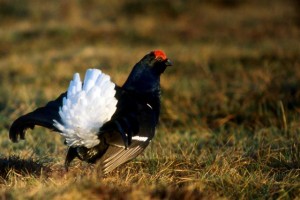
Male Black Grouse
Last weekend, fourteen pairs of black grouse arrived on Arran and it is hoped that the birds will reinstate the once booming population of black grouse on the island.
Historically, the black grouse received special protection in Arran. In 1703 in the book, “A Description of the Western Islands of Scotland”, author Martin Martin states that: “The blackcock is not allowed to be killed here without a permit; the transgressors are liable to a fine.”
This changed and in the nineteenth century large numbers were being shot. Until the 1950s, the black grouse was a common breeding species and was well distributed throughout the island. However, numbers continued to fall, and the last record was a single female in High Glen Cloy on 18 February 2000.
This decline was happening in almost all of western and central European countries, with black grouse numbers starting to fall in the latter half of the 19th century, accelerating over 1970 – 1990. In Britain, surveys carried out by the Royal Society for the Protection of Birds (RSPB), the Game Conservancy Trust (GCT) and Forest Enterprise (FE) show that the UK black grouse population fell from around 25,000 males in the early 1990s to an estimated 6,510 males in 1995/6.
The main reasons thought to have contributed to the decline of black grouse include loss of habitat through intensive sheep grazing, agricultural improvements and changes in agricultural practices; and increased numbers of predators such as foxes, especially where black grouse numbers are already low.
National Trust for Scotland Senior Ranger, Kate Sampson said, “It is great to see the black grouse finally arrive on Arran – this follows 8 years of planning and hard work by the Arran Black Grouse Group, supported by essential funding from the National Trust for Scotland and Scottish Natural Heritage – as well as generous donations from local businesses and individuals from Arran.
“We will now keep the females and few of the males in specially-designed pens intended to mimic natural habitat and reduce stress levels so that the birds can breed in safety this year. The chicks will then be released into the wild, where we hope they will flourish once again.”
Conservation experts will release a few unattached males in the next few weeks to enable them to set up territories and prepare for females who will be released later in the year.
